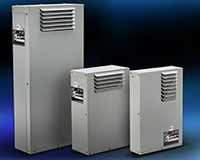Heat inside an enclosure can decrease the life expectancy of controlling units such as your PLC, HMI, AC drives and other items. Excessive heat can cause nuisance faults from your electrical and electronic components. Heat will also change the expected performance of circuit breakers and fuses, which can cause whole systems to shut down unexpectedly. So, if you have any electronic equipment or other heat sensitive devices, you may need cooling. But, once you have determined the source causing the enclosure’s internal temperature to rise, what factors should be considered for selecting a heat exchanger?
[hozbreak]
[two_columns border=”border”]
Heat Exchanger Selection
To select the proper size heat exchanger, the worst-case conditions should be considered. For a heat exchanger to work, the ambient air temperature must be lower than the desired internal enclosure air temperature.
There are three main factors in choosing a heat exchanger for an uninsulated metal NEMA rated enclosure located indoors:
[list style=”arrow” color=”blue”]
- Internal heat load
- Delta T
- Heat load transfer
[/list]
Internal Heat Load
Internal heat load is the heat generated by the components inside the enclosure. This can be determined by a few different methods. The preferred method is to add the maximum heat output specifications that the manufacturers list for all the
equipment installed in the cabinet. This is typically given in Watts.
Delta T (ΔT)
Delta T = maximum allowable internal enclosure temperature °F – maximum outside ambient temperature °F
Heat Load Transfer
Heat load transfer is the heat lost (negative heat load transfer) or gained (positive heat load transfer) through the enclosure walls with the surrounding ambient air. This can be calculated by the following formulas:
Surface Area (sq. ft.) = 2 [(H x W) + (H x D) + (W x D)] / (144 sq. inches/sq. ft.)
Note: Only include exposed surfaces of enclosue in calculations. Exclude surfaces such as a surface mounted to a wall.
Heat Load Transfer (W/°F) = 0.22 W/°F sq. ft. x surface area
Note: Use 0.22 Watts/°F sq. ft. for painted steel and nonmetallic enclosures. Use .10 Watts/°F sq. ft. for stainless steel and bare aluminum enclosures.
Cooling Capacity
Once you have determined your Internal Heat Load, the Heat Load Transfer and the Delta T, you can choose the proper size unit by calculating the needed cooling capacity.
Cooling Capacity (W/°F) = Internal Heat Load / ∆T – Heat Load Transfer[/two_columns]
[two_columns_last border=”border”]
Heat Exchanger Selection Example
A NEMA 12 Hubbell Wiegmann N12302412 enclosure (30″ high x 24″ wide x 12″ deep) contains a GS3-4010 AC drive 10 HP 460 volt) that has a maximum allowable operating temperature of 104°F and is located in a warehouse that has a maximum outside ambient air temperature of 90°F.
Power to be dissipated is stated in the specifications of the GS3-4010 and is found to be 345 watts.
Internal heat load:
Internal Heat Load = 345 Watts
Delta T:
∆T (°F) 104°F – 90°F = 14°F
Heat load transfer:
Surface Area (ft.²) = 2 [(30 x 24) + (30 x 12) + (24 x 12)] / 144 sq. inches = 19 ft.²
Heat Load Transfer = 0.22 x 19 ft.² = 4.2 Watts/°F
Cooling capacity:
Cooling Capacity = 345 Watts/14°F – 4.2 Watts/°F = 20.4 Watts/°F
In this example, you are able to determine that a Stratus heat exchanger, with a capacity of at least 20.4 Watts/°F is needed, such as a TE30-030-17-04.
*This selection procedure applies to metal and non-metal, uninsulated, sealed enclosures in indoor locations. This selection procedure gives the minimum required size; be careful not to undersize when purchasing.

[/two_columns_last]
[hozbreak]
All part numbers used in example are available at www.AutomationDirect.com/enclosure-cooling.
[hozbreak]

